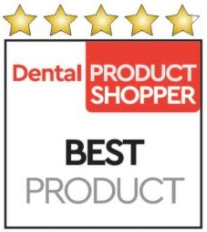ZR-C and ZR-P
Two materials, a universal post-try-in cleanser and a dental primer, remove phosphate contamination for enhanced bond strength to zirconia, alumina, and metal surfaces
It’s no surprise that Dr. Divyang Patel places great importance on “assuring the best bond between ceramic crowns and the tooth structure.” After all, most dentists are willing to bend over backwards to ensure a strong bond for their patients, even if that means adding an extra step to the bonding process.
By thoroughly cleaning and priming the restoration site prior to placement, ZR-C universal post-try-in cleanser and ZR-P universal primer from Vista Apex allowed Dr. Patel to “improve my ability to provide optimum bonded restorations to my patients.” While the products can be used separately, Dr. Patel experienced excellent results when using ZR-C and ZR-P together and ultimately decided that the cleanser and primer “should be a part of the cementation regimen for better bonding. It’s one extra step, but it is not too time consuming or technique sensitive.”
Unanimously agreeing that they would recommend ZR-C and ZR-P to their colleagues, all of the dentists who participated in this DPS review decided that these 2 products are worthy additions to their bonding and cementation protocols to ensure strong bonds to zirconia, alumina, and metal surfaces.
Ease of Delivery
Used to clean ceramic and metal substrates before bonding or cementing them in place, ZR-C is delivered via syringe with a Spira-Flo Brush Tip. “I like that ZR-C is in a syringe. I think it is easier to dispense evenly on the crown and leads to less waste than if it was in a dropper bottle,” explained Dr. Joshua Harezma. Packaged in a 4-mL bottle with 50 applicators, ZR-P is easy to apply to the restorative surface to improve bond strengths between resin materials and zirconia, alumina, and metal surfaces. Appreciating that ZR-P “is ready right out of the bottle,” Dr. Leonard Tau said both materials “offer superior delivery and easy handling and application.” While Dr. Andre Kanarki would like to see “better control on the ZR-C’s dispenser/plunger,” Dr. Paul Bookman said his favorite features are the simple packaging and dispensing. According to Dr. Karen Guo, “Both ZR-C and ZR-P are easy to use and do not add significant steps to the crown cementation process.”
Properties of ZR-C & ZR-P
An aqueous-based universal cleanser, ZR-C is used after try-in to non-abrasively clean the intaglio surface of prosthetic restorations. Combining 3 active monomers, ZR-P exhibits exceptional bond strength to even the most challenging substrates. “We place a lot of zirconia crowns and were interested in looking at other options to make the process simpler,” Dr. Tau shared. He decided that ZR-C and ZR-P did indeed “make the cementation and bonding process easier” and also appreciated that the products are “ready to use (no shaking required) and had optimized viscosity for easy handling and application.”
According to Vista Apex, ZR-C can be used with all dental restorative materials, which Dr. Raihan Nazir appreciated. “I found comfort in the predictability of use in all situations, be it crowns or veneers,” he said. He believes using a cleanser “is almost a necessary step in cases with less mechanical retention like veneers.” Dr. Harezma noted that ZR-C is “easier to place and easier to rinse off than competing products without any reduction in efficacy.” Dr. J. Michael Heider thought that ZR-P could be slightly more viscous, but Dr. Analia Veitz-Keenan said, “I like the viscosity and ease of use of ZR-C and ZR-P"
|
"I have seen less postop sensitivity and no issues with bond strength." |
"I like that ZR-C is in a syringe. I think it is easier to dispense evenly on the crown." |
"ZR-C and ZR-P made the cementation and bonding process easier." |
|
Paul Nguyen, DDS Prairieville, LA |
Joshua Haremza, DDS Palmyra, NY |
Leonard Tau, DMD Philadelphia, PA |

“These are great products and should be in every office that places zirconia restorations.”
- Raihan Nazir, DDS Anaheim Hills, CA
Improved Clinical Results
Previously concerned about postop sensitivity and bond strength after performing restorative procedures, Dr. Paul Nguyen found that implementing ZR-C and ZR-P into his routine improved clinical results and patient satisfaction. “In the short time I have tried these products, I have seen less postop sensitivity and no issues with bond strength,” Dr. Nguyen shared. “Anything that decreases the likelihood of zirconia crowns coming loose is a major plus,” stated Dr. Bookman, who proclaimed, “Time will tell, but ZR-C and ZR-P could be game changers for short clinical crowns with non-retentive preps.” Commenting that using these materials is “an easy way to clean the intaglio of the crown and increase cement adhesion to the crown,” Dr. Haremza said, “It saved me a few minutes after switching from my current system.”
Overall Satisfaction
“I plan to switch from my current system to ZR-P and ZR-C; they made the process of crown cementation more streamlined,” disclosed Dr. Harezma. Appreciating that the materials “can be used with all dental restorations,” Dr. Tau noted, “I highly recommend ZR-P and ZR-C. They are great products that are easy to use, and Vista Apex has the data to back up the products.” Dr. Nazir concluded, “These are great products and should be in every office that places zirconia restorations.”
Takeaways
• ZR-C and ZR-P can be used with all dental restorative materials
• ZR-C removes phosphate contamination from zirconia surfaces
• ZR-P enhances bond strength to zirconia, alumina, and metal restoration
• Optimized viscosity for easy handling and application
• Both materials help streamline the crown cementation process










